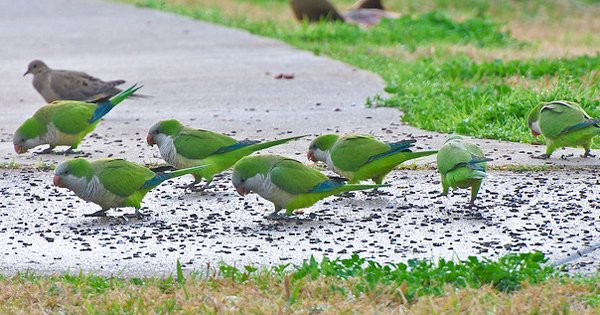Myiopsitta monachus
Monk Parrots
Synonym(s):
Class: Aves
Order: Psittaciformes
Family: Psittacidae

Photographer: Alex Reshanov
Source: http://invasivespecieseast.blogspot.com/2012_01_01_archive.html
Description
Monk parrots (Myiopsitta monachus), also referred to as green parrots were originally seen only in pet stores and homes throughout the United States as a chatty pet. Now, the bright green parrot can be seen in feral populations sometimes as common as a pigeon. Monk parrots can be identified by orange bills, bright green bodies on the dorsal side, some blue tail feathers, and white chests. Adults are 29 cm long and have a wingspan of 48 cm. Females can be slightly smaller than males, but are not identifiable based on dimorphism or external genitalia.
Ecological Threat: Initially, it was feared that monk parrots would become an agriculture pest due to a possibility of large populations concentrated in one area. However, monk parrots have not been observed to threat agriculture, but rather cause the most damage to electrical lines and utility poles. Monk parrots survive cold weather by building large elaborate nests with several mating pairs combined. Nests are usually a very large conglomeration of sticks and utilize power lines for nest support causing power outages. Simple removal of the nest doesn't solve the problem, monk parrots observed rebuilding a nest within an hour of the removal, and in the same location.
Biology: Monk parrots have a relatively long lifespan of 15-20 years, and reported occurrences of 25-30 year life spans. By comparison to other parakeets, 30 years is one of the highest recorded life expectancies of parrots. Monk parrots lay 5-12 white eggs that hatch within an average of 24 days.
History: Monk parrots were introduced to the United States in the 1960's from South America as exotic pets. Monk parrots escaped accidentally and were released in various parts of the United States. They become established due to their high tolerance for a wide range of temperatures, including extreme cold and hot weather. In 1992 importation of the monk parrot was banned, but sale and breeding within in the United States is tolerated at the discretion of individual states.
U.S. Habitat: A high tolerance for temperature extremes has allowed the monk parrot to become established in several states all over the U.S. including Austin, TX and Brooklyn, NY which provide drastically different climates for the resident monk parrots. Nests built by monk parrots are not typical of other parrots, and involve elaborate structures made of sticks weighing as much as 400 lbs. Mating pairs, numbering as many as 20, will inhabit the same large nest, providing warmth for the high density population.
Distribution
Native Origin: South America
U.S. Present: CA, CT, FL, IL, KT, MA, NJ, NY, OH, RI, TX, WA
For a map (provided by EDDMapS) of current county distribution click here.
Management
Disagreements arise regarding the appropriate managment response to the establishment of monk parrots in the United States. Some invasive species experts believe the monk parrot is not a nuisance and can be tolerated in the metropolitan ares in which it inhabits by building alternative nesting sites removing the problem of the birds creating large nests in man made structures such as power lines, cell phone towers, and stadium lights. In their native South America, monk parrots build nests in trees, and resort to other structures when tree populations are lacking. Other experts argue that the population should be controlled and eradicated, but large management plans have not been released.
Text References
Internet References
http://invasivespecieseast.blogspot.com/2012_01_01_archive.html
http://www.chron.com/CDA/archives/archive.mpl/2009_4753178/south-american-parrots-at-home-in-houston-gray-bir.html
 Texas Invasive Species Institute
Texas Invasive Species Institute